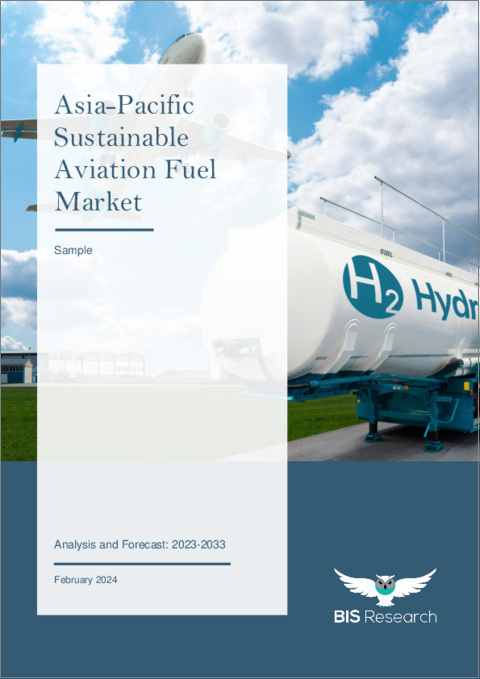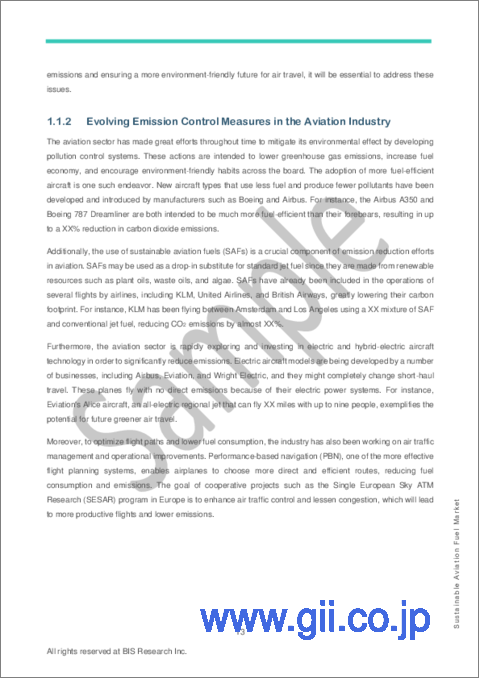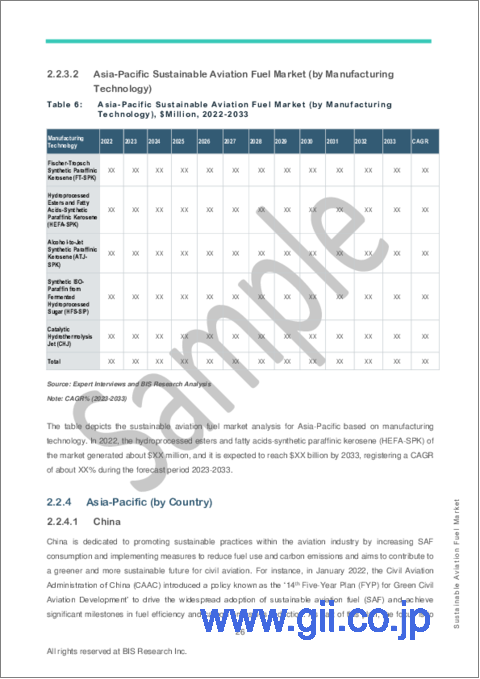|
|
市場調査レポート
商品コード
1422243
アジア太平洋の持続可能な航空燃料市場:分析と予測(2023年~2033年)Asia-Pacific Sustainable Aviation Fuel Market: Analysis and Forecast, 2023-2033 |
||||||
カスタマイズ可能
|
|||||||
| アジア太平洋の持続可能な航空燃料市場:分析と予測(2023年~2033年) |
|
出版日: 2024年02月09日
発行: BIS Research
ページ情報: 英文 90 Pages
納期: 1~5営業日
|
全表示
- 概要
- 図表
- 目次
アジア太平洋の持続可能な航空燃料の市場規模は、2023年の3億8,000万米ドルから2033年には392億3,000万米ドルに達し、予測期間の2023年~2033年の成長率は58.99%に達すると予測されています。
この分野の成長は、持続可能な航空燃料(SAF)の生産能力の向上、サプライチェーン管理の効率化、コストの低減につながる最先端技術と協力関係によって推進されます。
| 主要市場統計 | |
|---|---|
| 予測期間 | 2023年~2033年 |
| 2023年の評価 | 3億8,000万米ドル |
| 2033年予測 | 392億3,000万米ドル |
| CAGR | 58.99% |
アジア太平洋では、持続可能な航空燃料(SAF)の採用と関心が大幅に高まっています。従来の航空燃料に代わるよりクリーンな燃料を求める世界の動向は、気候変動や航空産業の生態系への影響に関連する環境問題の高まりと一致しています。バイオマス、使用済み食用油、水素などの持続可能な資源から得られるSAFは、こうした課題に対する実行可能な解決策を提供します。アジア太平洋のSAF市場は、最先端技術と戦略的パートナーシップの融合によって著しい成長を遂げています。こうした動きは、SAFの製造能力を高め、サプライチェーン・ロジスティクスを合理化し、製造コストを引き下げています。しかし、SAFがその潜在能力をフルに発揮し、アジア太平洋地域における航空旅行のより持続可能な未来に貢献するためには、重要な課題に対処しなければならないです。これには、生産規模の拡大、安定した原料供給の確保、SAF採用を支援しインセンティブを与える強固な規制枠組みの確立などが含まれます。
当レポートでは、アジア太平洋の持続可能な航空燃料市場について調査し、市場の概要とともに、用途別、燃料タイプ別、製造技術別、国別の動向、および市場に参入する企業のプロファイルなどを提供しています。
目次
エグゼクティブサマリー
調査範囲
第1章 市場
- 業界の展望
- ビジネスダイナミクス
第2章 地域
- 持続可能な航空燃料市場(地域別)
- アジア太平洋
- 市場
- 用途
- 製品
- アジア太平洋(国別)
第3章 市場-競合ベンチマーキングと企業プロファイル
- 競合ベンチマーキング
- 企業プロファイル
第4章 調査手法
List of Figures
- Figure 1: Asia-Pacific Sustainable Aviation Fuel Market, $Billion, 2022-2033
- Figure 2: Asia-Pacific Sustainable Aviation Fuel Market, Million Gallon, 2022-2033
- Figure 3: Asia-Pacific Sustainable Aviation Fuel Market (by Application), $Billion, 2022 and 2033
- Figure 4: Asia-Pacific Sustainable Aviation Fuel Market (by Fuel Type), $Billion, 2022 and 2033
- Figure 5: Asia-Pacific Sustainable Aviation Fuel Market (by Manufacturing Technology), $Billion, 2022 and 2033
- Figure 6: Sustainable Aviation Fuel Market (by Region), $Billion, 2033
- Figure 7: Sustainable Aviation Fuel Market, Business Dynamics
- Figure 8: Jet Fuel Prices, May 2018-March 2023
- Figure 9: Share of Key Business Strategies and Developments, January 2020-June 2023
- Figure 10: Sustainable Aviation Fuel Market, Competitive Benchmarking
- Figure 11: Research Methodology
- Figure 12: Top-Down and Bottom-Up Approach
- Figure 13: Assumptions and Limitations
List of Tables
- Table 1: Market Developments, January 2020-June 2023
- Table 2: Partnerships, Collaborations, Agreements, and Contracts, January 2020-June 2023
- Table 3: Sustainable Aviation Fuel Market (by Region), Million Gallon, 2022-2033
- Table 4: Sustainable Aviation Fuel Market (by Region), $Million, 2022-2033
- Table 5: Asia-Pacific Sustainable Aviation Fuel Market (by Application), $Million, 2022-2033
- Table 6: Asia-Pacific Sustainable Aviation Fuel Market (by Fuel Type), Million Gallon, 2022-2033
- Table 7: Asia-Pacific Sustainable Aviation Fuel Market (by Fuel Type), $Million, 2022-2033
- Table 8: Asia-Pacific Sustainable Aviation Fuel Market (by Manufacturing Technology), $Million, 2022-2033
- Table 9: China Sustainable Aviation Fuel Market (by Application), $Million, 2022-2033
- Table 10: China Sustainable Aviation Fuel Market (by Fuel Type), Million Gallon, 2022-2033
- Table 11: China Sustainable Aviation Fuel Market (by Fuel Type), $Million, 2022-2033
- Table 12: India Sustainable Aviation Fuel Market (by Application), $Million, 2022-2033
- Table 13: India Sustainable Aviation Fuel Market (by Fuel Type), Million Gallon, 2022-2033
- Table 14: India Sustainable Aviation Fuel Market (by Fuel Type), $Million, 2022-2033
- Table 15: Japan Sustainable Aviation Fuel Market (by Application), $Million, 2022-2033
- Table 16: Japan Sustainable Aviation Fuel Market (by Fuel Type), Million Gallon, 2022-2033
- Table 17: Japan Sustainable Aviation Fuel Market (by Fuel Type), $Million, 2022-2033
- Table 18: Rest-of-Asia-Pacific Sustainable Aviation Fuel Market (by Application), $Million, 2022-2033
- Table 19: Rest-of-Asia-Pacific Sustainable Aviation Fuel Market (by Fuel Type), Million Gallon, 2022-2033
- Table 20: Rest-of-Asia-Pacific Sustainable Aviation Fuel Market (by Fuel Type), $Million, 2022-2033
“The Asia-Pacific Sustainable Aviation Fuel Market Expected to Reach $39.23 Billion by 2033.”
Introduction to Asia-Pacific Sustainable Aviation Fuel Market
The Asia-Pacific sustainable aviation fuel market is estimated to reach $39.23 billion by 2033 from $0.38 billion in 2023, at a growth rate of 58.99% during the forecast period 2023-2033. Growth in the sector is propelled by state-of-the-art technology and collaborations, leading to increased production capacity for Sustainable Aviation Fuel (SAF), enhanced efficiency in supply chain management, and lowered costs.
| KEY MARKET STATISTICS | |
|---|---|
| Forecast Period | 2023 - 2033 |
| 2023 Evaluation | $0.38 Billion |
| 2033 Forecast | $39.23 Billion |
| CAGR | 58.99% |
Market Introduction
The Asia-Pacific (APAC) region is witnessing a significant surge in the adoption and interest in Sustainable Aviation Fuel (SAF). This global trend towards cleaner alternatives to traditional aviation fuels aligns with the growing environmental concerns related to climate change and the ecological impact of the aviation industry. SAF, derived from sustainable sources such as biomass, used cooking oil, or hydrogen, offers a viable solution to these challenges. The APAC SAF market is experiencing notable growth, driven by the convergence of cutting-edge technologies and strategic partnerships. These developments are enhancing SAF manufacturing capabilities, streamlining supply chain logistics, and driving down production costs. However, for SAF to achieve its full potential and contribute to a more sustainable future for air travel in the APAC region, critical issues must be addressed. These include scaling up production, ensuring a consistent supply of feedstock, and establishing robust regulatory frameworks to support and incentivize the adoption of SAF.
Market Segmentation:
Segmentation 1: by Application
- Commercial Aviation
- Business and General Aviation
- Military Aviation
- Unmanned Aerial Vehicle (UAV)
Segmentation 2: by Fuel Type
- Hydrogen Fuel
- Biofuel
- Power-to-Liquid Fuel
- Gas-to-Liquid Fuel
Segmentation 3: by Manufacturing Technology
- Fischer-Tropsch Synthetic Paraffinic Kerosene (FT-SPK)
- Hydroprocessed Esters and Fatty Acids-Synthetic Paraffinic Kerosene (HEFA-SPK)
- Alcohol-to-Jet Synthetic Paraffinic Kerosene (ATJ-SPK)
- Synthetic ISO-Paraffin from Fermented Hydroprocessed Sugar (HFS-SIP)
- Catalytic Hydrothermolysis Jet (CHJ)
Segmentation 4: by Country
- Japan
- India
- China
- Rest-of-Asia-Pacific
How can this report add value to an organization?
Product/Innovation Strategy: The product segment helps the reader understand the different types of products available for deployment and their potential. Moreover, the study provides the reader with a detailed understanding of the sustainable aviation fuel market by application (commercial aviation, business and general aviation, military aviation and unmanned aerial vehicle (UAV), product on the basis of fuel type (hydrogen fuel, biofuel, power-to-liquid fuel, and gas-to-liquid fuel), manufacturing technology (fischer-tropsch synthetic paraffinic kerosene (FT-SPK), hydroprocessed esters and fatty acids-synthetic paraffinic kerosene (HEFA-SPK), alcohol-to-jet synthetic paraffinic kerosene (ATJ-SPK), synthetic ISO-paraffin from fermented hydroprocessed sugar (HFS-SIP), and catalytic hydrothermolysis jet (CHJ).
Growth/Marketing Strategy: The sustainable aviation fuel market has seen major development by key players operating in the market, such as business expansion, partnership, collaboration, and joint venture. The favored strategy for the companies has been merger and acquisition to strengthen their position in the sustainable aviation fuel market.
Competitive Strategy: Key players in the APAC sustainable aviation fuel market analyzed and profiled in the study involve major sustainable aviation fuel offering companies providing sustainable aviation fuel and different manufacturing technology. Moreover, a detailed competitive benchmarking of the players operating in the sustainable aviation fuel market has been done to help the reader understand how players stack against each other, presenting a clear market landscape. Additionally, comprehensive competitive strategies such as partnerships, agreements, and collaborations will aid the reader in understanding the untapped revenue pockets in the market.
Table of Contents
Executive Summary
Scope of the Study
1. Markets
- 1.1. Industry Outlook
- 1.1.1. Sustainable Aviation Fuel Market: Overview
- 1.1.2. Evolving Emission Control Measures in the Aviation Industry
- 1.1.3. Emerging Zero Emissions Aircraft Technology
- 1.1.3.1. Electric Propulsion Systems
- 1.1.3.2. Hydrogen Fuel Cell Technology
- 1.1.3.3. Advanced Aerodynamics and Lightweight Materials
- 1.1.3.4. Urban Air Mobility (UAM) and Electric Vertical Take-Off and Landing (eVTOL)
- 1.1.4. Current and Future Technological Trends
- 1.1.4.1. Carbon Capture and Utilization (CCU) Technologies
- 1.1.4.2. Direct Air Capture (DAC) Technologies
- 1.1.5. Evolving Aviation Propulsion Technologies: Migration Toward Reduced Emissions
- 1.1.6. Critical Success Parameters for Sustainable Aviation Fuel Adoption
- 1.2. Business Dynamics
- 1.2.1. Business Drivers
- 1.2.1.1. Increasing Environmental Concerns
- 1.2.1.2. Volatile Jet Fuel Prices
- 1.2.1.3. Advances in Conversion Technologies
- 1.2.2. Business Challenges
- 1.2.2.1. Infrastructure Development Cost
- 1.2.2.2. Certification and Sustainability Criteria
- 1.2.2.3. Inadequate Supply of Feedstock
- 1.2.3. Business Opportunities
- 1.2.3.1. SAF Offtake Agreements
- 1.2.4. Business Strategies
- 1.2.4.1. Market Developments
- 1.2.4.2. Partnerships, Collaborations, Agreements, and Contracts
- 1.2.1. Business Drivers
2. Region
- 2.1. Sustainable Aviation Fuel Market (by Region)
- 2.2. Asia-Pacific
- 2.2.1. Market
- 2.2.1.1. Key Players in Asia-Pacific
- 2.2.1.2. Business Drivers
- 2.2.1.3. Business Challenges
- 2.2.2. Application
- 2.2.2.1. Asia-Pacific Sustainable Aviation Fuel Market (by Application)
- 2.2.3. Product
- 2.2.3.1. Asia-Pacific Sustainable Aviation Fuel Market (by Fuel Type)
- 2.2.3.2. Asia-Pacific Sustainable Aviation Fuel Market (by Manufacturing Technology)
- 2.2.4. Asia-Pacific (by Country)
- 2.2.4.1. China
- 2.2.4.1.1. Market
- 2.2.4.1.1.1. Key Players in China
- 2.2.4.1.2. Application
- 2.2.4.1.2.1. China Sustainable Aviation Fuel Market (by Application)
- 2.2.4.1.3. Product
- 2.2.4.1.3.1. China Sustainable Aviation Fuel Market (by Fuel Type)
- 2.2.4.1.1. Market
- 2.2.4.2. India
- 2.2.4.2.1. Market
- 2.2.4.2.1.1. Key Players in India
- 2.2.4.2.2. Application
- 2.2.4.2.2.1. India Sustainable Aviation Fuel Market (by Application)
- 2.2.4.2.3. Product
- 2.2.4.2.3.1. India Sustainable Aviation Fuel Market (by Fuel Type)
- 2.2.4.2.1. Market
- 2.2.4.3. Japan
- 2.2.4.3.1. Market
- 2.2.4.3.1.1. Key Players in Japan
- 2.2.4.3.2. Application
- 2.2.4.3.2.1. Japan Sustainable Aviation Fuel Market (by Application)
- 2.2.4.3.3. Product
- 2.2.4.3.3.1. Japan Sustainable Aviation Fuel Market (by Fuel Type)
- 2.2.4.3.1. Market
- 2.2.4.4. Rest-of-Asia-Pacific
- 2.2.4.4.1. Market
- 2.2.4.4.1.1. Key Players in Rest-of-Asia-Pacific
- 2.2.4.4.2. Application
- 2.2.4.4.2.1. Rest-of-Asia-Pacific Sustainable Aviation Fuel Market (by Application)
- 2.2.4.4.3. Product
- 2.2.4.4.3.1. Rest-of-Asia-Pacific Sustainable Aviation Fuel Market (by Fuel Type)
- 2.2.4.4.1. Market
- 2.2.4.1. China
- 2.2.1. Market
3. Markets - Competitive Benchmarking & Company Profiles
- 3.1. Competitive Benchmarking
- 3.2. Company Profiles
4. Research Methodology
- 4.1. Factors for Data Prediction and Modeling





